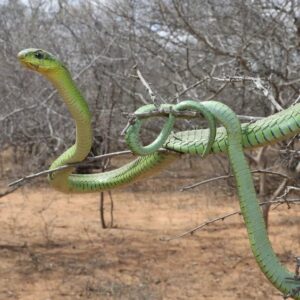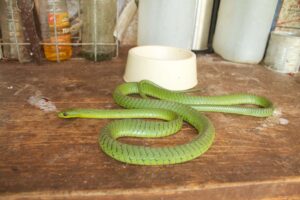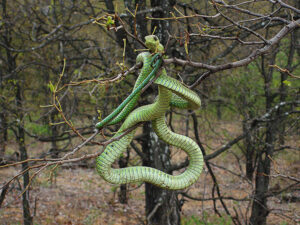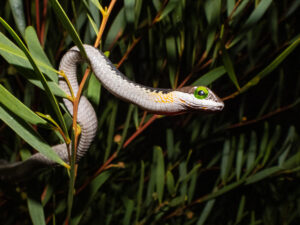Boomslang, a big and highly venomous snake species, is indigenous to sub-Saharan Africa. Their name ‘boom’, and ‘slang’, translates to ‘tree’ and ‘snake’ in the Afrikaan language, resulting in their common name, tree snake.
The boomslang was depicted in the famous book series Harry Potter by J.K. Rowling, where the polyjuice potion was made from its skin.
Scientific Classifications
- Suborder:Serpentes
- Family:Colubridae
- Genus:Dispholidus
- Species:D. typus
Conservation Status
Description
Size
The adults measure between 3.3 and 5.2 ft, though some could reach lengths of around 6ft. These slender-bodied snakes have an average weight of 0.660 lb, varying from 0.386 lb to 1.124 lb.
Color and Appearance
These snakes exhibit sexual dimorphism when it comes to color. The males appear light green, with the edges of their scale being blue or black. Some boomslang males may be of a different coloration from their clan, black above and bright yellow on the undersides. On the other hand, the female boomslang isn’t as colorful as its male counterpart, having a brown or reddish body.
The juveniles have a unique coloration helping them to camouflage with their natural surroundings well. They have a twig-colored body, white throat, and bright emerald eyes. The young snakes take quite a few years to acquire the adult color.
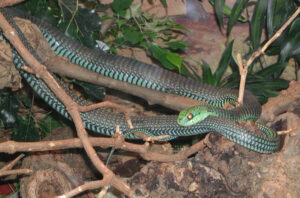
One of the striking physical features of the boomslang is their enormous eyes, alongside their egg-shaped head. Their big eyes and the round pupil within give them good eyesight. They often move their head from one side to the other to better visualize the objects in front of them.
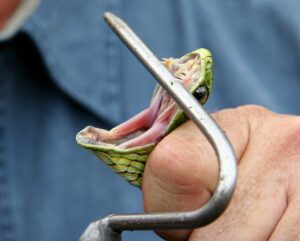
These snakes have three big fangs right at the back of their mouth, visible just below their eyes when their mouth is wide open. Their enlarged teeth situated at the back portion of their jaws helps in injecting the venom into the body of their prey.
They even have a slightly compressed body. The dorsal scales are oblique and narrow with apical pits or indented dots in 19-21 rows. Their tail appears long, while the subcaudal scales, i.e., those placed on their tail’s ventral side, are arranged in pairs. All the scales have a keeled appearance giving the snake’s body a rough texture.
Are They Dangerous to Humans
Yes, they are increasingly dangerous to humans, capable of delivering venom of high potency level through the enormous fangs lying behind their jaws. However, it is needful to mention that the boomslang is timid and bites when confronted or mishandled.
While attacking or biting its opponent, it can open its jaw to as much as 170 °. They have slow-acting venom, which takes about 24-48 hours to produce the actual symptoms, giving the victim false assurance regarding the seriousness of the bite. If medical attention is not provided instantly, their bite could be fatal. Some symptoms that develop over time due to their bite include external and internal bleeding, sleepiness, nausea, mental disorders, and headaches.
One example of how fatal a boomslang bite can be when not addressed in time is the unfortunate incident that happened to Karl Patterson Schmidt, an American herpetologist.
In 1957 a juvenile boomslang had bitten him, though he didn’t take it that seriously, thinking that a small snake like this one couldn’t be that harmful. Instead, he kept recording his symptoms till a few moments before he died.
The boomslang monovalent antivenom developed in the 1940s.
Boomslang Snake at a Glance
Distribution
Its range centers around sub-Saharan Africa, native to South Africa, Botswana, Mozambique, Namibia, and Eswatini.
Habitat
The boomslang mostly dwells in savannas, lowland forests, karoo shrubs, and grasslands. These arboreal snakes are good climbers. However, they don’t just live on trees but also on land where they feed, forage or even seek shelter. They go into brumation or become dormant in cold weather, taking shelter underground or even hiding inside nests of weaverbirds, curling themselves up there.
Lifespan
The boomslang snakes live for around eight years in the wild.
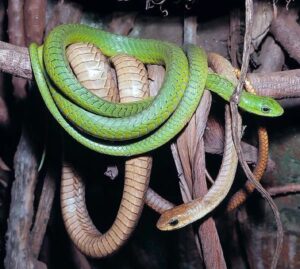
Predators
Some of the common predators of the boomslang include birds like falcons, ospreys, kestrels, and secretary birds. The mongoose is also said to prey upon these snakes.
Diet
The boomslang mainly feeds on frogs, chameleons, and other tree-living lizards, other snakes, and their own fellow mates, too, thus showing cannibalistic traits. They occasionally eat birds, eggs of nesting birds, and small mammals.
Reproduction
These snakes are oviparous, with the females laying around 30 eggs in one go, deposited in rotting logs or hollows of tree trunks. Like most snake species, the female boomslangs also don’t care for their young and move away right after laying the eggs.
The eggs incubate for quite a while, around three months on average. Sexual dimorphism is seen in the male and female hatchlings, the former appearing grey with patches of blue, while the latter has a brown body. The hatchlings are not harmful to humans when they are 7.9 inches long. However, after measuring 18 inches, they become dangerously venomous.
Similar Species
It is shorter in size than the boomslang and much more dangerous too.
Green Mamba
They have a greater similarity to the boomslang because of their green body. However, the green mamba is longer, heavier, and deadlier than the boomslang.
One could distinguish them by the black spots against their green body and shorter body stature. These snakes are non-venomous, unlike the boomslang.
Source
africansnakebiteinstitute.com, eol.org, animaldiversity.org, flickr.com, toiimg.com, photogallery.indiatimes.com, fineartamerica.com, monaconatureencyclopedia.com

